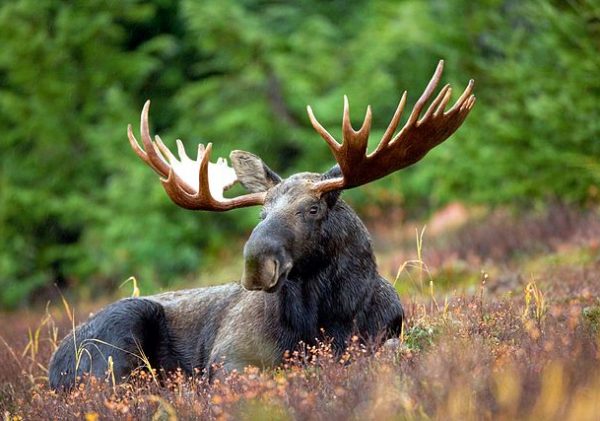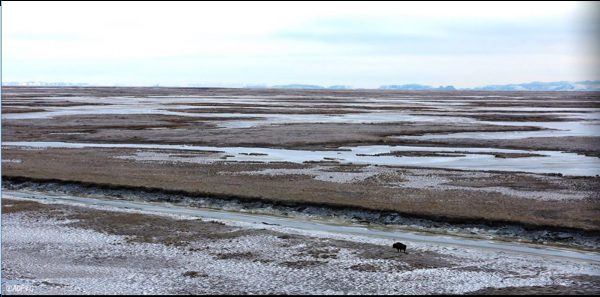
A small group of state wildlife managers have the unusual job of alerting the public whenever there is weird animal news. That can mean opening a hunt for a musk ox stranded on an ice-berg, telling dog-owners to keep pets away from nesting cranes, or reminding Anchorage residents not to leave caribou carcasses in their back yards (because it invites bears). It’s work that is equal parts literary and zoological, according to one of the preeminent wordsmiths of wildlife management.
Ken Marsh is sitting in his office. It’s a small, dim room on the second floor of a government building in Anchorage. The kind of office that could just as easily belong to an accountant or insurance salesman.
Except for the sizable stuffed ram’s head hanging over the desk. It’s a dall sheep with thick curling horns Marsh shot in the eighties. For a long time it only ever adorned his residences. Until he started working for the Department of Fish and Game.
“I needed to do something with it, and I thought ‘what more appropriate place than right here in my office where I can look at it during the day and evoke some memories,'” Marsh explained.
“Also, I guess it’s sort of a marker: this guy’s a hunter,” Marsh added. “Which I am.”
Marsh grew up in Alaska during the late sixties and seventies, an avid outdoors-man for a young age. He even spent time living in a 14-by-20 cabin while a trapper in the Susitna Valley.
“We trapped off of snowshoes for martin, mink, beaver,” Marsh counted off.
The social opportunities weren’t ideal for a young man, and it was a hard way to make a living, which led Marsh to decide he needed to find a more long term job.
From the time he was in high school his passion was split between biology and writing.
“When I got into college I realized biologists had to do a lot of math. And journalists didn’t,” Marsh said. “So journalism ended up winning.”
Marsh spent the next few decades working in newspapers and magazines, from the Valdez Vanguard to writing a fishing column at the Anchorage Daily News. His enthusiasm for the outdoors never dimmed.
In 2008, he started working for ADF&G’s sportfish division before moving over to his current role on the game side of the department as a public information officer. Which means it’s Marsh’s job to write press releases that can make an impact. Like this one from January 31, 2017:
“Alaska’s fledgling wood bison herd lost an important member Friday when Bison No. 124 was illegally shot and killed near the village of Quinhagak.”
It was an especially somber and poetical communique, with a subject line that read “Wood Bison Death Leaves Unfortunate Void.”
“A wanderer that captured the hearts of rural communities across western Alaska, Bison 124 was a young cow known for its extensive exploration of the Yukon, Kuskokwim, and Innoko drainages,” it goes on.
This not your run-of-the-mill press release. Especially from a branch of state government. Marsh writes about all the communities that reported sightings of this particular wood bison, and permeating the prose is a sentimental note of loss. Marsh said he channeled that tone from what the wildlife biologist in charge of the wood bison program relayed to him.
In the email sent to the Alaska media, a photo was attached. It featured a lone bison standing before a vast expanse of tundra, melting snow, and small, nameless ponds.

“Bison 124 had a knack for identifying suitable habitat where future generations of bison could prosper… Valuable knowledge the animal gained can no longer be shared with the main herd, and is now lost,” the release goes on.
Ultimately, the tale of Wood Bison 124 made it into newspapers and the evening news.
“It was known to scientists as Wood Bison 124,” KTUU’s Travis Khachatoorian announced. “But to those closely following the project, she was so much more than a number.”
Marsh is fully aware that good writing with a bit of flair is instrumental getting information from management biologists to the public. But that information can start off wonky and dense.
“When I work with our biologists,” Marsh explained, “there is a certain amount of scientific jargon that is a part of their every day speech.”
Marsh sees his work as translating. With just a dash of gentle literary media manipulation, too. All to help coax the public into better grasping the complicated interactions between wildlife and the humans who live nearby.
“So that people can actually enjoy the resource, so that the wildlife doesn’t crash,” Marsh said. “That’s what wildlife management’s really all about.”
With his words, he’s helping keep the outdoors wild.
Zachariah Hughes reports on city & state politics, arts & culture, drugs, and military affairs in Anchorage and South Central Alaska.
@ZachHughesAK About Zachariah




